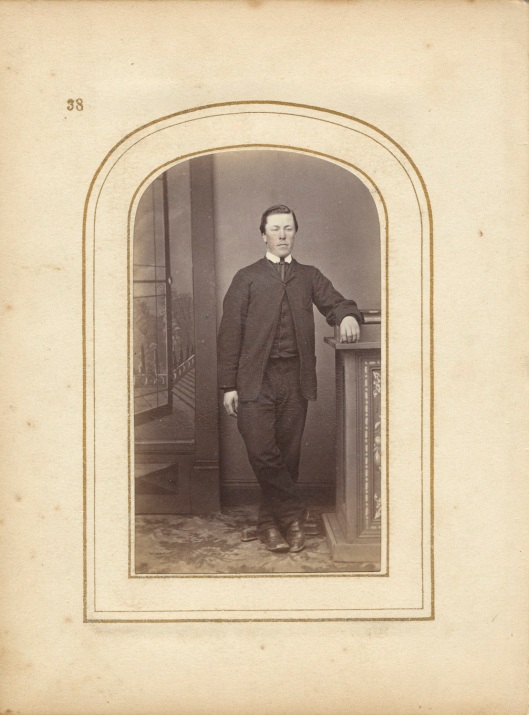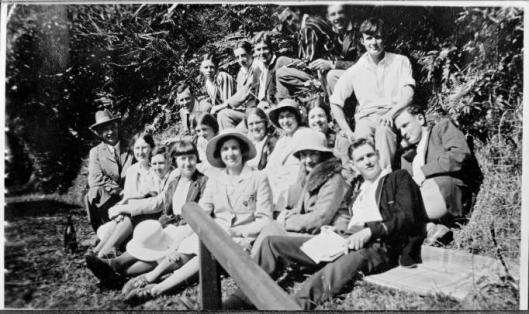Tags
1900s, 1910s, 1920s, 1930s, 1940s, 1970s, 1980s, 1990s, classics, economics, education, English, French, geology, Higher Education Development Centre, history, medicine, philosophy, physics, psychology, teaching, technology

WR Morris lecturing in the ‘old anatomy lecture theatre’ – now the Gowland Lecture Theatre – in the Lindo Ferguson Building, 1949. Anatomical drawings and skeletons were popular visual aids from the medical school’s earliest classes onwards. Image courtesy of the Hocken Collections, University of Otago Medical School Alumnus Association archives, MS-1537/441, S17-550c.
The University of Otago’s founders followed Scottish precedent in their choice of curriculum and also in teaching methods: rather than the Oxbridge-style tutorial, teaching was based on the professorial lecture. That had the advantage of being economical and many subjects got by with just one staff member for the first few decades. The professor did all the teaching, except in the sciences, which were first to acquire assistants, necessary because of the laboratory classes which supplemented lectures. Humanities subjects had no tutorials until the 1940s, though in some cases the classes were small enough that professors became well acquainted with their students. As mentioned in a recent post about the history department, history professor John Elder told a young lecturer whose students showed marked progress after he introduced seminar discussions: ‘These young men like to hear themselves talk but you’re paid to lecture and you’ll therefore lecture. So long as I’m head of this department, there’ll be no discussions’.
Elder was not the only professor suspicious of tutorials. They eventually sneaked into arts subjects as the rehabilitation department funded tutorials for returned servicemen and women in the wake of World War II; they became standard additions to the lecture programme soon after that. Sometimes the impetus for this innovation came from students and sometimes from staff. In 1948 Frank Mitchell, the education professor, reported that ‘this year the Honours students on their own initiative organised tutorials for students taking Education I. I hope that it will soon be possible to conduct regular tutorials for all stages’. In the same year departing philosophy professor David Raphael noted that tutorials were ‘not just a desirable luxury’ in that subject, but ‘essential for adequate training. Philosophy is a way of doing things with one’s mind, not a set of facts to be learned, and consequently the student must be in a position to practise the accomplishment in question’. Tutorials required a bigger investment in staff, but the growing student roll justified that.
Academics of course varied greatly in their teaching styles. Founding classics professor George Sale, notorious for his disdain of students’ abilities, preferred the stick to the carrot. John Murdoch, in reminiscences of his own teaching career, wrote of meeting some of Sale’s honours students after a lecture in 1907: ‘They had just received their corrected Latin proses, and the most successful had gained a mark of “minus 300”. Sale deducted marks, 10, 50, 100 or more for a mistake, according to his estimate of its seriousness’. Murdoch had little respect for the methods of the early 20th century professors: ‘Otago University as I knew it was in effect a glorified coaching school’. Although the academic staff were ‘capable and well-qualified’, suggested Murdoch, their teaching was determined by a system whereby courses were ‘set by regulations applying to all four [University of New Zealand] colleges, and the success of their efforts was gauged by examiners in England’. Such conditions made ‘inspirational teaching almost hopeless if not quite impossible’, at least in English, ‘a notoriously difficult subject to teach’. Future high school principal Muriel May, an Otago student of the 1910s and 1920s, recalled that Thomas Gilray, the English professor, ‘taught by dictating at a relentless pace to his benches of scribbling students in the Lower Oliver classroom …. at the prearranged dates we regurgitated. There were no seminars, no discussions, originality was not fostered nor were personal opinions encouraged’. There were always, of course, some inspiring teachers. May also recalled that George Thompson’s French lectures ‘were invariably stimulating and enjoyable. (Latin students made comparable claims for the classes of Professor Adams.)’ Lecturer Agnes Blackie was in love with physics, which she found ‘brimful of interest’. ‘I can’t imagine a better subject for a lecturer’, she wrote in her reminiscences. ‘Lectures can be illustrated with fascinating demonstrations which bring the subject to life for the students and are fun for the lecturer to operate’.
From the 1950s, with greater local control of the curriculum and the widespread use of tutorials in addition to the traditional lectures, labs, clinical teaching and field trips, academic staff had greater flexibility in teaching. Their adoption of new technologies varied. Visual aids did not have to be high-tech: the beautiful anatomical drawings of John Scott, who was a skilled artist as well as first dean of the medical school, were used at Otago for many decades. Others used glass slides and a ‘magic lantern’ projector to show images. John Mackie recounted its use by Noel Benson in 1929 first-year geology lectures; it was ‘a contraption on a tripod which stood behind the lecture bench. Believe it or not, this projector incorporated an arc-lamp which spluttered, fizzed and made other dangerous noises, although as a source of light it was quite spectacular’. The notoriously absent-minded professor occasionally tripped over its wires ‘and the whole contrivance would crash to the floor’; that happened also on the day he rushed to extinguish the light after discovering students had replaced his first slide with a full-frontal nude. Slides remained a popular teaching tool, though shown through a more compact slide projector from the mid-20th century, with the slides themselves shifting from glass to film negative to digital format.
In 1940 the dean of arts and sciences, Robert Bell, reported that several departments took advantage of a new scheme for borrowing ‘sound-films’, finding them ‘an extremely valuable and effective addition’ to teaching methods. Not every academic liked new technology; John Howells, who retired from the economics department in the 1990s, commented ‘my major advancement in the technology area stopped with the biro pen’. The emergence of the Audio Visual Learning Centre (AVLC) in 1973 ‘was regarded with suspicion by some staff members who had visions of classes being handed over to various mechanical gadgets’, reported the staff newsletter in 1977. By then, the ‘prejudice’ was ‘disappearing’, with 30 departments already using the AVLC. Its use ranged from ‘tape/slide/workbook programmes’ for anatomy courses to a ‘film providing “evidence” for a simulated Supreme Court trial’ for law students. The impetus for the centre came from the medical school, which was concerned about how it would manage its larger intake of students; it provided space for AVLC academic director David Teather and his team, with a production centre in the Adams building and a study centre with library of audio visual resources in the Scott building.

By the time this photo was taken in 1983, medical school lectures had become much more relaxed and technology enabled the use of film and other audiovisual aids. Please get in touch if you can help identify the lecturer or class! Image courtesy of the Hocken Collections, University of Otago Photographic Unit archives, MS-4368/086, S17-550b.
Academics using the AVLC ‘face some adjustment of their teaching methods and their attitudes’, noted the staff newsletter in 1975. There was already wider consideration of teaching and learning methods in the university, which new technology helped accelerate. In 1971 the lecturers’ association ran a well-attended seminar on teaching methods and suggested the university set up a research centre on higher education. In 1973 Otago appointed Terry Crooks as a lecturer in the education department, with half of his time devoted to research and advice on university teaching. He, the lecturers’ association and AVLC ran occasional sessions on teaching methods; for instance, a 1976 session looked at the use of film in university teaching, with staff discussing Otago-made films they had used in anthropology, physical education and medicine. Psychology lecturer Louis Leland ‘introduced a film which demonstrated the training of laboratory rats’. He made ‘a similar film each year with rats trained by the current year’s students and uses this to demonstrate to the following year’s students that training rats is within their capability’. In 1976 senate established a higher education research and advisory centre (HERAC) committee. HERAC and the AVLC often worked together and in 1978 they merged under a new acronym, this time destined to last: HEDC, or the Higher Education Development Centre.
Although HEDC had few staff in its early years, it performed a significant role; ‘there was growing awareness of the need for stimulating teaching’ reported the director, David Teather, in 1983. A recent two-day seminar on ‘helping students succeed’ had attracted 140 staff and ‘there was now hardly a department which did not make regular use of the resources at HEDC’ for producing teaching aids. That was just as well, since students ‘now came from school expecting to make use of technology in their work’. Computers became a significant part of that technology, and in 1986 Graham Webb joined the HEDC team; his ‘major responsibility’ was ‘to advise staff members on the educational uses of computers on campus’. Otago’s computing services centre also developed a team with expertise in computer-aided learning and in the 1990s HEDC’s audio-visual production section joined them as part of information technology services. HEDC continued to research and disseminate information on tertiary teaching, provide advice and run courses, notably for new academic staff; from 1996 staff could obtain a formal qualification – a postgraduate diploma in tertiary teaching – taught by the centre. The centre also supported Otago staff from other departments working on teaching-related research and new innovations. To help ‘enhance’ learning and teaching, the university offered special grants for research and innovation in teaching.
HEDC assisted with course evaluations, which gave students an opportunity to provide feedback on their teachers and courses. Staff could use them to identify weaknesses in their teaching which required work, or as evidence of their skills when seeking promotion. In an era of growing emphasis on quality assurance, they helped ‘measure’ courses in departments which were up for review. With a growing body of research from staff and postgraduate students on many aspects of higher education, plus a range of courses and support services for academics wanting to make their teaching more effective, Otago had travelled a long way from the days of Sale scoring papers at ‘minus 200’ and Gilray ‘dictating at a relentless pace’.

A class underway in the late 1980s or early 1990s in the Castle Lecture Theatres. The overhead transparency was a popular teaching tool for many years, later largely overtaken by Powerpoint digital slides. Unfortunately, the resolution of this old negative isn’t good enough to read what’s on the screen – if you can identify the class, lecturer or year, please get in touch! Image courtesy of the Hocken Collections, University of Otago Photographic Unit archives, MS-4185/060, S17-550a.












